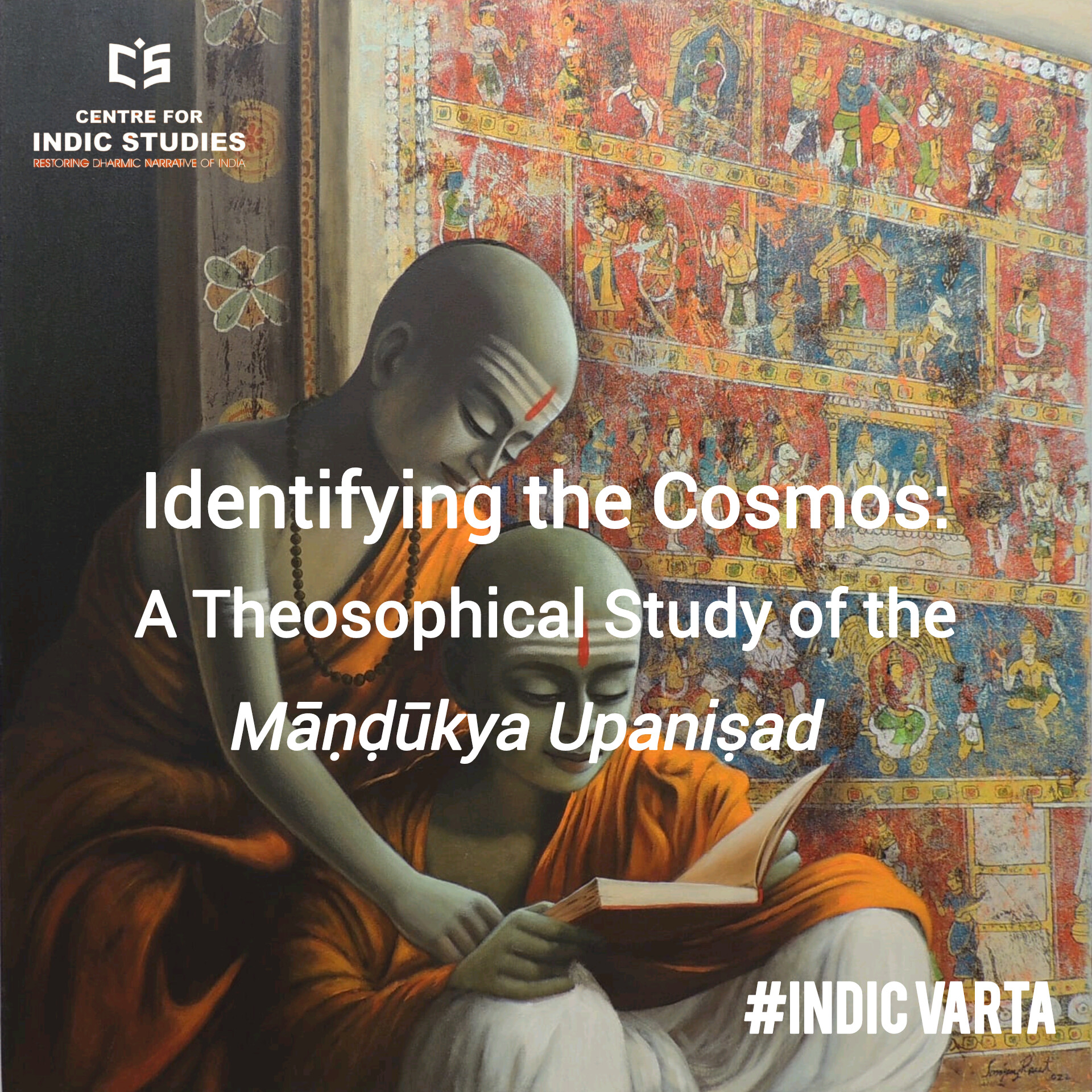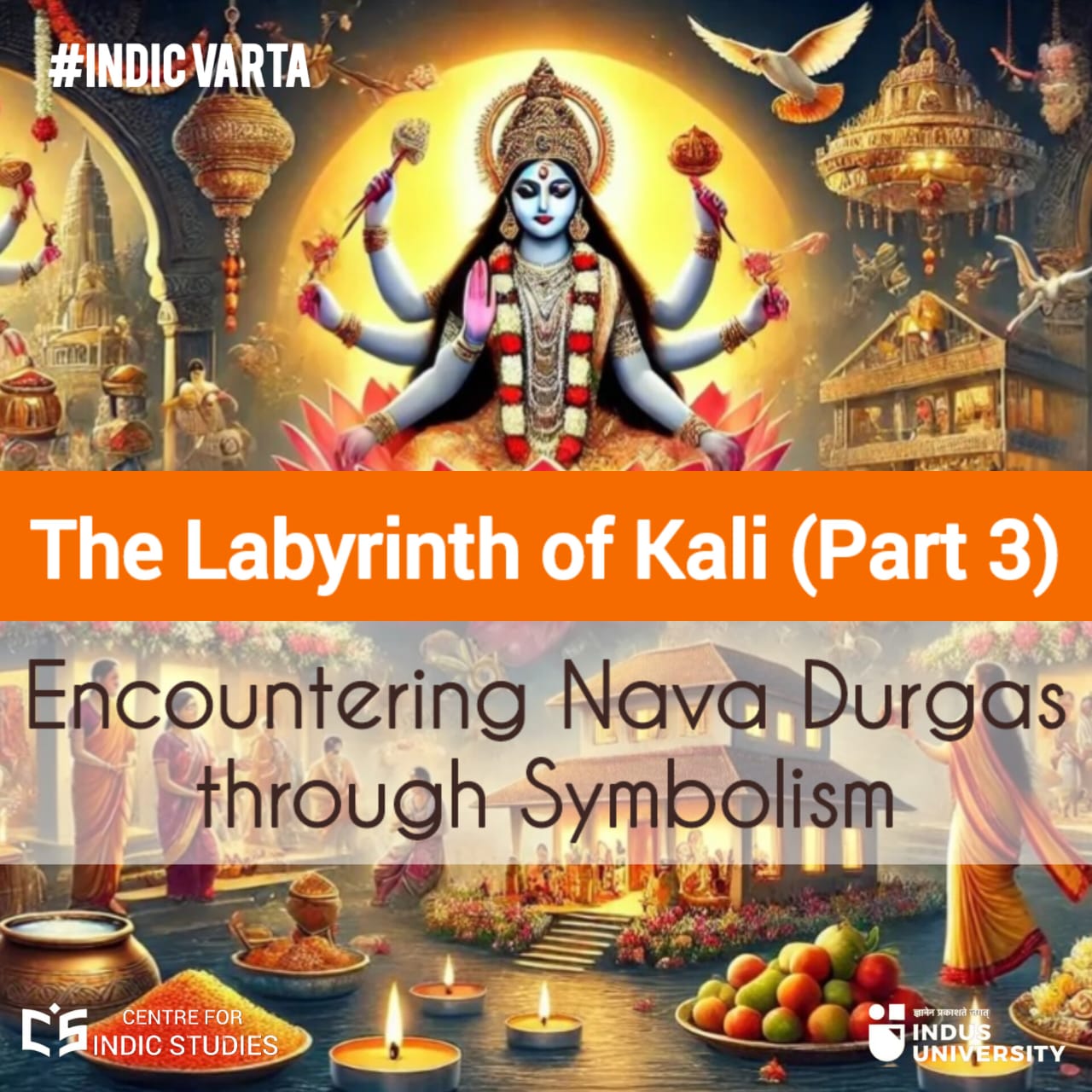- Visitor:79
- Published on: 2024-09-19 03:53 pm
Identifying the Cosmos: A Theosophical Study of the Māṇḍūkya Upaniṣad (Part II)
The precision and laconism of the Māṇḍūkya Upaniṣad in identifying the cosmos hermeneutically erect it as a theosophical ekphrasis. Enucleating the multitudinous vista of esoteric wisdom in few scientific words or letters has always been the way of great minds— be they the physicists and scientists of modern times, or the ṛṣis, munis, and sādhus of ancient India. Much in a harmonic unison, they both work for the amelioration of the mankind by illuminating the human consciousness to the ultimate munificence.

(Continued from the first part)
प्राज्ञ: -- The Cosmic Everything
Dr. Michio Kaku, a professor of theoretical physics at the City University of New York and one of the foremost physicists of the present generation, notes in the beginning of his latest title, The God Equation: The Quest for a Theory of Everything, that it was Albert Einstein’s unfinished dream to find one equation that would describe everything— a mission which latter physicists termed as ‘the theory of everything’. Albert Einstein’s most talked about equation in the theoretical physics of special relativity (i.e. E = mc2) is also termed as the ‘mass-energy equivalence’ as it scientifically proves that mass and energy are “intimately related” (Rodgers, 2014). To simplify the theory, it can be said that when energy is condensed, it takes the form of mass and, alternatively, when mass is exploited, it takes the form of energy. This incomprehensible “intimately related” state of the mass and energy is astonishingly similar to the implication of the Saṃskṛta word ‘सुषुप्त:’ used in the fifth mantra of the Māṇḍūkya Upaniṣad. This esoteric wisdom has been hailed as the ‘प्राज्ञ:’ or ‘the cosmic everything’ as it is the state when mass and energy is not considered as separate entities, but rather as one and uniform. It states:
यत्र सुप्तो न कञ्चन कामं कामयते नकञ्चन स्वप्नं पश्यति तत्सुषुप्तम्।
सुषुप्तस्थानएकीभूतः प्रज्ञानघन एवानन्दमयोह्यानन्दभुक्चेतोमुखः प्राज्ञस्तृतीयः पादः॥
[Where there is no desire, no illusion, and no enchantment, that slumberous, tranquil, wise, and blissful state is omniscient. Its physicality is derived from the condensation form of the ānanda or energy and therefore it is a dream-like state. It is the third feature of the Brahma.]
In this mantra, it is implicated that the third pāda of the Brahma is the “intimately related” state of the dormant energy that is there within the mass. It is the omnicompetent, omnipresent, and omniscient aspect of the cosmic functionality as per the Māṇḍūkya Upaniṣad. That is why, it has been called as the ‘प्राज्ञ:’ or the cosmic everything (or cosmic all-knowing). By this term, the omniscient Brahma has been venerated as it is the one behind the creation of the cosmos. In some texts of the Sanātana Dharma, it has been ascribed as the ‘ānanda’ (the cosmic ecstasy) and ‘sat’ (the eternal). By this mantra, not only the nature of the paramātmā (the cosmic spirit), but that of the jīvātmā (the human spirit) has also been explicated. However, since the latter resides in the former, the term ‘प्राज्ञ:’ is more convivially applicable to the latter. As Ādi Śankāracārya in his commentaries on the Brahmasūtra (1.3.42) asserts that as the virtue of omniscience belongs to the supreme spirit, the term ‘प्राज्ञ:’ depicts the ‘सुषुप्त:’ nature of the Brahma:
ॐ सुषुप्त्युत्क्रान्त्योर्भेदेन ॐ॥
[Because of the declaration of being different in sleep and at the time of departure, the Brahma is the subject matter of teaching.]
Apart from this, the great master of advaita darśana has also deciphered this aspect with terms like ‘prajñānaghana’ and ‘ānandamaya’ which mark them assigned to the omniscient Brahma. That is why, the sixth mantra of the Māṇḍūkya Upaniṣad further enunciates:
एष सर्वेश्वरः एष सर्वज्ञ एषोऽन्तर्याम्येषयोनिः सर्वस्य
प्रभवाप्ययौ हि भूतानाम् ॥
[It is the god of gods, it is omniscient. It is self-fulfilled and the reason behind every function of the universe. Creation, preservation, and destruction all happens because of this and within this.]
The abovementioned mantra demonstrates that this Brahma is the ‘सर्वेश्वरः’ (the god of gods) who is all-pervasive and the sole cause of function of the cosmos. Therefore, the previously uttered words such as the ‘वैश्वानरः’, ‘तैजस:’, and ‘प्राज्ञ:’ are actually bynames of the one and absolute Brahma.
अचिन्त्य: -- The Cosmic Nothing
Whereas Einstein’s theory could explain the macrocosmic phenomena of the universe, the microcosmic phenomena can only be described properly by the quantum theory which was first suggested by another Nobel laureate physicist named Max Planck. Later, physicists like Bohr, Schrӧdinger, Heisenberg, Feynman, Louis de Broglie, and many others developed this theory which holds a probabilistic view of the cosmos. Nearly all of them were heavily influenced by the Upaniṣads. But, most importantly, it is the Nobel Prize winning physicists like Schrӧdinger, Heisenberg, and Bohr, who openly embraced the notions of the Vedānta. For instance, the German physicist, Dr. Hans-Peter Dürr, whose research works attune with Ādi Śankāracārya’s theory of māyā, asserts while discussing on the quantum theory: “I studied the matter for the last 35 years, only to find out that it does not exist! I have been studying something that does not exist” (Sri Sri Ravi Shankar, 2012). Now, let us proceed to the next śloka of the Māṇḍūkya Upaniṣad:
नान्तःप्रज्ञं न बहिष्प्रज्ञं नोभयतःप्रज्ञं नप्रज्ञानघनं
न प्रज्ञं नाप्रज्ञम्। अदृष्टमव्यवहार्यमग्राह्यमलक्षणं
अचिन्त्यमव्यपदेश्यमेकात्मप्रत्ययसारं प्रपञ्चोपशमं
शान्तं शिवमद्वैतं चतुर्थं मन्यन्ते स आत्मा स विज्ञेयः॥
[It neither knows the inside, nor the outside. It knows no side. It is nowhere. It knows nothing. It does not see, nor can it be seen. It cannot be used. It cannot be accepted. It does not have any feature or aspect. It cannot be thought of. It is not located anywhere. The only proof of its existence is itself because it does not exist. It is the tabula rasa, non-dual, and it is the summum bonum. One who knows this feature of the Brahma that it cannot be known is a wise man.]
It dilates that the fourth pāda of the Brahma is that it is neither knowledgeable from the intrinsic cognition, nor from the extrinsic one; neither it conceives, nor can it be conceived; it is neither conscious, nor unconscious; it cannot be exploited or used by anyone or any means; it cannot be accepted by anyone; it does not have any characteristic; it cannot be understood by thinking; it cannot be seen or visualized in any form; it exists, and it does not exist; it is the all-pervasive summum bonum that is surrounded by a state like tabula rasa; it is formless, shapeless, unseen, unobservable, inaudible, and non-dual. In brief, it is the ‘nirguṇa nirākāra’ aspect of the Brahma— the kind of hypotheses that quantum physicists put forward as the identity of the cosmos.
With the proliferative mathematical equations and hypotheses on the intriguing phenomena such as the black holes, the dark matter, and the dark energy, the implication of the constant employment of negating epithets in this mantra of the Māṇḍūkya Upaniṣad has regained prominence and garnered much discussion in the community of philosophers as well as physicists. As a result, the cosmic nothingness has emerged as a bona fide field of study in the academia and many contemplate it as the ‘next big thing’ in astrophysics. Tim Folger, the winner of the American Institute of Physics Science Writing Award (2007), espouses the view that “when the next revolution rocks physics, chances are it will be about nothing— the vacuum, that endless infinite void…Empty space wasn’t always so mystifying. Until the 1920s physicists viewed the vacuum much as the rest of the rest of us still do: as a featureless nothingness, a true void. That all changed with the birth of quantum mechanics” (2008).
ॐ – The Theosophical Theory of Everything
“I want to know how God created this world”, said Albert Einstein in 1925, “I’m not in this or that phenomenon. I want to know His thoughts; the rest are just details” (Lincoln, 2019). It was Einstein’s audacious attempt to eventually reach to one conclusive equation in theoretical physics that would encapsulate all the mechanisms that lay behind all the functions of the cosmos. After Einstein’s demise, Stephen Hawking had initially carried this work of developing a theory of everything, but he abandoned the project, stating that “our search for understanding will never come to an end and that we will always have the challenge of new discovery. Without it, we would stagnate” (2002). However, physicists have not utterly defenestrated the search for such a theory and, as a result, the string theory (with all its variations and limitations) has emerged as the latest theory. It is the only theory which applies the laws of the quantum theory and the theory of relativity in amalgamation and poses a mathematical hypothesis which inclines to win the coveted title. But the problem with string theory is that it cannot be tested physically and it seems very unlikely to be tested in near future as well.
Thus, laying bare the aftermath of the endeavour of the physicists by far, one might embark to galvanize a theory of everything from the theosophical perspective. Here comes the role of Māṇḍūkya Upaniṣad as it distinctively puts forward ‘a theosophical theory of everything’:
सोऽयमात्माध्यक्षरमोङ्कारोऽधिमात्रं पादा मात्रा मात्राश्च पादा अकार उकारो मकार इति ॥
[That Paramātmā (the supreme being), whose four pādas (features) have been described before, has three mātrās (dimensions) and it is not separate from those three. These three mātrās are the ‘अ’ or the ‘a’ sound, ‘उ’ or the ‘u’ sound, and ‘म’ or the ‘m’ sound respectively.]
It is the ‘ॐ’ which has been hailed as the be-all and the end-all of everything. It is both sākāra (formative) and nirākāra (formless). The three mātrās (i.e. ‘अ’, ‘उ’, and ‘म’) are the formative structure of the cosmos, all embodying different aspects. The ‘ॐ’ is regarded as the ‘प्रणव:’ that is formed by three phonetic sounds: ‘अ’, ‘ऊ’, and ‘म’ (a-u-m). These three sounds are symbolically encrypted, each representing three different aspects. The first sound ‘अ’ (a) stands for Brahmā who is the ‘नाद’ (sound of creation); the second sound ‘ऊ’ (u) stands for Viṣṇu who is the ‘बिन्दु’ (the preserver or container which nurtures the creation); and the last sound ‘म’ (m) stands for Śiva who is the ‘कला’ (the art of destruction). Commingled together, they become the “ब्रह्मज्योति” (the Supreme Being). As Svāmī Nigamānanda has inculcated in his magnum opus, Yogīguru (p. 36):
शिवो ब्रह्मा तथा विष्णुरोङ्कारे च प्रतिष्ठिता:।
अकारश्च भवेद्व्रह्मा उकारः सच्चिदात्मकः॥
मकारो रुद्र इत्युक्तः शीक्षाध्यायः इति उच्यते॥
[According to the true teaching of wisdom, Brahmā, Viṣṇu, and Śiva are together called the ‘ॐ’ in which the ‘अ’ stands for Brahmā, the ‘ऊ’ stands for Viṣṇu, and the ‘म’ stands for Śiva.]
The Māṇḍūkya Upaniṣad interprets the three mātrās of the ‘ॐ’ as three cosmological phenomena which act as constituents:
जागरितस्थानो वैश्वानरोऽकारः प्रथमामात्रा ऽऽप्तेरादिमत्त्वाद्
वाऽऽप्नोति ह वै सर्वान्कामानादिश्च भवति य एवं वेद ॥
[The first mātrā ‘अ’ is the root of all the physical manifestations of the cosmos and it is called the ‘वैश्वानरः’. In other words, it is the bodily aspect of the cosmos. One who knows it, that person becomes fulfilled in all aspects.]
As the śabda (sound) ‘अ’ has a very subtle presence in all the words of the cosmos, it is the root of all sounds. That is why, in the Aitareya Āraṇyaka (2.3.6) of the Veda, it has been asserted: “अकारो वै सर्वा वाक्” (all sounds stem from the ‘अ’ sound). Śrī Kṛṣṇa in the Bhāgavad Gītā (10.33) has also stated that among all the akṣaras, he is the ‘अ’ sound. As the ‘अ’ sound refers to the physical form of the cosmos, it is also called the first pāda or the body of the Brahma which was previously termed as the ‘वैश्वानरः’. In other words, the ‘वैश्वानरः’ is abbreviated as the ‘अ’ of the ‘ॐ’ sound.
The tenth mantra of the Māṇḍūkya Upaniṣad explains that the second mātrā ‘ऊ’ symbolizes the intangible energy of the cosmos:
स्वप्नस्थानस्तैजस उकारो द्वितीया मात्रोत्कर्षात्
उभयत्वाद्वोत्कर्षति ह वै ज्ञानसन्ततिं समानश्च भवति
नास्याब्रह्मवित्कुले भवति य एवं वेद ॥
[The second mātrā ‘ऊ’ is the root of all the intangible energetic features of the cosmos and it is called the ‘तैजस:’. In other words, it is the energy of the cosmos. One who knows it, that person excels in attaining the true wisdom.]
This ‘ऊ’ is the second pāda of the Brahma and it is the source of all the energy of the cosmos. In other words, it is energy itself. It has been called a ‘dream like state’ in the Māṇḍūkya Upaniṣad due to its extreme subtlety, intangibility, and abstractness— drawing a parallel with theoretical physics where we have already discovered that energy is always a subtle state and not a massy physical one.
The third mātrā ‘म’ indicates the diminution of the cosmos. That is why, epistemologically it can be denominated as a nihilistic proportion of the cosmos:
सुषुप्तस्थानः प्राज्ञो मकारस्तृतीयामात्रा मितेरपीतेर्वा
मिनोति ह वा इदं सर्वमपीतिश्च भवति य एवं वेद ॥
[The third mātrā ‘म’ is the unit of scaling or the ‘प्राज्ञ:’ as it refers to the destruction of all of the cosmos. In other words, it is destruction itself as it swallows everything of the cosmos when its time comes. One who knows it, that person truly reckons the cosmos.]
The third mātrā ‘म’ etymologically originates from the ‘मा’ dhātu (verbal root in Saṃskṛta language) which means ‘to calculate’ or ‘to scale’. As it is the last mātrā, it is also the one which scales the former two (i.e. the ‘अ’ and the ‘ऊ’). Whereas the ‘अ’ refers to the sthūla (concrete) aspect, the ‘ऊ’ refers to the sūkṣma (subtle) aspect, and the ‘म’ refers to the kāraṇa (abstract) aspect.
However, the epigram occurs in the last mantra of the Māṇḍūkya Upaniṣad where it is stated that when these three mātrās are amalgamated, they become the one and absolute ‘ॐ’ which is beyond all mātrās:
अमात्रश्चतुर्थोऽव्यवहार्यः प्रपञ्चोपशमः शिवोऽद्वैत
एवमोङ्कार आत्मैव संविशत्यात्मनाऽऽत्मानं य एवं वेद ॥
[The praṇava dhvani ‘ॐ’ is ‘अमात्र’ (beyond and without mātrā or dimension). It is beyond the māyā (illusion). It is the most benevolent. It is one, absolute, and non-dual. It is the fourth pāda of the Brahma and one who knows it, that person’s ātmā (spirit) attains the grace of the Paramātmā.]
Thus, the four pādas of the Brahma constitute the cosmos and govern its functions. To some extent, it can be called agathokakological in nature, but its true nature cannot be expressed in verbal testimonies. Whereas the ‘अ’, ‘ऊ’, and ‘म’ epitomize the three dimensional perception, their commingled avatāra ‘ॐ’ is the n-dimensional reality which cannot be fathomed by the mundane consciousness. Whereas the three mātrās are sākāra (corporeal), their unison is nirākāra (incorporeal). Thus, an assumption drawn from this ‘theosophical theory of everything’ is worth considering for scholarly dictum.
The ‘ॐ’ is unquestionably the most sacred, sublime, and scientific sound of the universe since time immemorial, according to the Sanātana Dharma. It is the sound that was heard when the creation of the universe took place, it can be heard now at present in the radioactive frequency of the cosmos, and it shall be heard when the destruction of the universe shall take place. In the Sanātana Dharma, this is the most revered sound of all. All the mantras of the Veda incept with it, so do they end as well. Chanting any mantra without this sacred sound in the beginning and at the end is actually a vainglorious attempt of oblivious wit. That is why, bhagavāna Śrī Kṛṣṇa has advised in the Bhāgavad Gītā (8.13):
ओमित्येकाक्षरं ब्रह्म व्याहरन्मामनुस्मरन्।
य: प्रयाति त्यजन्देहं स याति परमां गतिम्॥
[One who chants the akṣara ‘ॐ’ and contemplates on me all his life, eventually attains mokṣa by my grace.]
Conclusion
The precision and laconism of the Māṇḍūkya Upaniṣad in identifying the cosmos hermeneutically erect it as a theosophical ekphrasis. Enucleating the multitudinous vista of esoteric wisdom in few scientific words or letters has always been the way of great minds— be they the physicists and scientists of modern times, or the ṛṣis, munis, and sādhus of ancient India. Much in a harmonic unison, they both work for the amelioration of the mankind by illuminating the human consciousness to the ultimate munificence as the śānti mantra of the Māṇḍūkya Upaniṣad sings:
ॐ भद्रंकर्णेभिः श्रुणुयाम देवा भद्रं पश्येमाक्षभिर्यजत्राः।
स्थिरैरङ्गैस्तुष्टुवा ̐˴सस्तनूभिर्व्यशेम देवहितं यदायुः॥
स्वस्ति न इन्द्रो वृद्धश्रवाः स्वस्ति नःपूषा विश्ववेदाः।
स्वस्ति नस्तार्क्ष्यो अरिष्टनेमिः स्वस्ति नो बृहस्पतिर्दधातु॥
॥ॐ शान्तिः शान्तिः शान्तिः॥
[O divine! May our ears hear what is good, may our eyes see what is beautiful, may our organs be serviceable to wellbeing, and may our lifespan be spent in doing good deeds. May Indra, the lord of the heaven, protect us; may Sūryadeva, the lord of the sun and the solar system, cherish us. May Garuḍa, the cosmic bird of Viṣṇu, diminish our vices. May Bṛhaspati, the guru of the divine wisdom, enlighten us. May there be śāntiḥ (cosmic peace) of the three tāpas— the ādhyātmika, the adhidaivika, and the adhibhautika.]
- 39 min read
- 5
- 0










